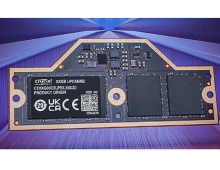
Intel, Micron Introduce 25-Nanometer NAND
Intel and Micron Technology, Inc. today announced the world's first 25-nanometer (nm) NAND technology, which provides a more cost-effective path for increasing storage capacity in popular consumer gadgets as well as the latest solid-state drives (SSDs).
NAND flash memory stores data and other media contained in consumer electronics products, retaining information even when the power is turned off. The drive toward smaller NAND processes enables the continued development and introduction of new uses for the technology. Not only is the 25nm process the smallest NAND technology, it is also the smallest semiconductor technology in the world.
Manufactured by IM Flash Technologies (IMFT), Intel and Micron?s NAND flash joint venture, the 25nm process produces 8 gigabytes (GB) of storage in a single NAND device, creating a high-capacity storage solution for today?s tiny consumer gadgets. It measures just 167mm2-- small enough to fit through the hole in the middle of a compact disc (CD), yet packs more than 10 times the data capacity of that CD (a standard CD holds 700 megabytes of data).
Intel and Micron have doubled NAND density roughly every 18 months, which leads to smaller, more cost-efficient and higher capacity products. IMFT started production with a 50nm process in 2006, followed by a 34nm process in 2008.
The 25nm, 8GB device is sampling now and is expected to enter mass production in the second quarter of 2010. For consumer electronics manufacturers, the device provides the highest-density in a single 2 bits-per-cell multi-level cell (MLC) die that will fit an industry-standard, thin small-outline package (TSOP). Multiple 8GB devices can be stacked in a package to increase storage capacity. The new 25nm 8GB device reduces chip count by 50 percent compared to previous process generations, allowing for smaller, yet higher density designs and greater cost efficiencies. For example, a 256GB solid-state drive (SSD) can now be enabled with just 32 of these devices (versus 64 previously), a 32GB smartphone needs just four, and a 16GB flash card requires only two.
Manufactured by IM Flash Technologies (IMFT), Intel and Micron?s NAND flash joint venture, the 25nm process produces 8 gigabytes (GB) of storage in a single NAND device, creating a high-capacity storage solution for today?s tiny consumer gadgets. It measures just 167mm2-- small enough to fit through the hole in the middle of a compact disc (CD), yet packs more than 10 times the data capacity of that CD (a standard CD holds 700 megabytes of data).
Intel and Micron have doubled NAND density roughly every 18 months, which leads to smaller, more cost-efficient and higher capacity products. IMFT started production with a 50nm process in 2006, followed by a 34nm process in 2008.
The 25nm, 8GB device is sampling now and is expected to enter mass production in the second quarter of 2010. For consumer electronics manufacturers, the device provides the highest-density in a single 2 bits-per-cell multi-level cell (MLC) die that will fit an industry-standard, thin small-outline package (TSOP). Multiple 8GB devices can be stacked in a package to increase storage capacity. The new 25nm 8GB device reduces chip count by 50 percent compared to previous process generations, allowing for smaller, yet higher density designs and greater cost efficiencies. For example, a 256GB solid-state drive (SSD) can now be enabled with just 32 of these devices (versus 64 previously), a 32GB smartphone needs just four, and a 16GB flash card requires only two.





















